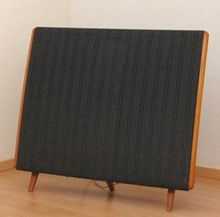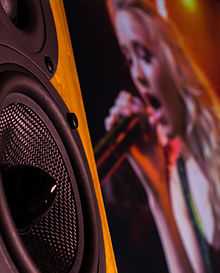Quad Electroacoustics
 | |
| Type | Private limited company |
|---|---|
| Industry | Home entertainment equipment manufacturing & distribution |
| Founded | 1936 |
| Headquarters | Huntingdon, Cambridgeshire, England |
| Products | Hi-fi equipment |
| Parent | International Audio Group |
| Website | www.quad-hifi.co.uk |
Quad Electroacoustics is a British manufacturer of hi-fi equipment, based in Huntingdon, England.
Corporate history
The company was founded by Peter J. Walker in 1936 in London, and was initially called S.P. Fidelity Sound Systems. In 1936 the name was changed to the Acoustical Manufacturing Co. Ltd. The company moved from London to Huntingdon in 1941 after being bombed out of London in World War II.
The company initially produced only public address equipment but after the war they began to produce equipment designed for use in the home as a result of the rising demand for high quality domestic sound reproduction. Within a few years the company had transitioned almost entirely to manufacturing models for the home audio market.
The name "QUAD" is an acronym for "Quality Unit Amplifier Domestic", used to describe the QUAD I amplifier. In 1983, when having become known for their QUAD range of products, the Acoustical Manufacturing Co. Ltd changed its name to QUAD Electroacoustics Ltd.
In 1995, QUAD Electroacoustics Ltd was bought by Verity Group plc, joining its existing brands of Wharfedale and Mission. A few changes were made, including shifting all production to Shenzhen, China.[1]
In September 1997 the company changed ownership again as Verity Group sold off businesses to finance its development of flat panel loudspeakers. With Wharfedale it became part of the International Audio Group under the management of Bernard and Michael Chang. Since Walker's death in 2003, the firm has had only its design ethos—"the closest approach to the original sound"—in common with the British hi-fi firm he founded in 1936.[2]
In 2003, a book was commissioned "QUAD The Closest Approach" which offered a history of the company from its creation to that point.
Audio products
The company's first products were released in 1948. The QA12 and QA12/P were low-powered mono valve designs. This unit's sound quality reproduction was high compared with other products on the market at the time, and was thus adopted for use by the BBC.
Amplification


Following the mass production of 'stereo' vinyl records in 1958, the QC 22 control unit was developed and released in 1959. This was a stereo control unit that was designed to be used with a pair of QUAD II mono power amplifiers. To complement the QUAD II, the company also produced AM and FM tuners for use with the QC II & 22 control units.
The company made the transition to transistor-powered models in 1966 with the "professional" QUAD 50 monoblock which had a tapped transformer output and then the commercial 33/303 preamplifier and stereo power amplifier combination and later with the 44/405 and subsequent 66/606 and 909 models. They also made a range of AM and FM tuners.
Product Range
- Control Unit – Pre Amplifiers
QUAD 33 – 1967 to 1982 – 120,000 units
QUAD 44 – 1979 to 1989 – 40,000 units
QUAD 34 – 1982 to 1995 – 41,000 units
QUAD 66 – 1989 to 1996 – 12,000 units
QUAD 77
QUAD 99
- Current Dumping Power Amplifiers
QUAD 405 – 1975 to 1982 – 64,000 units
Quad 405–2 1982 to 1993 – 100,000 units
Quad 306 – 1986 to 1995 – 25,000 units
Quad 606 – 1986 to 1997 – 27,700 units
Quad 707
Quad 909
- Other (Conventional) Power Amplifiers
Quad 303 – 1967 to 1985 – 94,000
Quad 77 Integrated
Loudspeakers

In late 1949 (or early 1950), the company launched the CR corner ribbon loudspeaker. This used a Goodmans Axiom 150 cone loudspeaker for the lower frequencies and an electromagnetic ribbon loudspeaker, designed by Acoustical, for the higher frequencies. Fewer than one thousand units were sold.
In 1957, the company made history when they released Quad Electrostatic Loudspeaker (ESL), the world's first production full frequency range electrostatic loudspeaker renowned for sonic transparency and very low distortion. Its sonic neutrality and transparency were offset by its extreme directionality, moderate power handling, the need for a large room, and moderate bass extension; its novel electrical characteristics could render some amplifiers unstable, which could result in damage to either or both.
The ESL was quickly adopted by the BBC for monitoring the sound quality of their broadcasts. The BBC eventually replaced them with moving coil based monitor speakers developed by several manufacturers, such as the highly successful LS3/5A, that were more easily transported and stored, and were more representative of typical contemporary hi-fi speakers.
Quad launched ESL-63, successor to the original ESL, in 1981. The newer design featured larger panels and an innovative stator design, made up of eight concentric rings fed from the centre outwards through analogue delay lines, so that the audio signal radiated out as though emanating from a single point. Subsequent electrostatic models, the 988/989 and then the 2805/2905 were successive refinements of the ESL-63 design, featuring increased power handling and output levels, more sophisticated overload protection, and greater structural rigidity.
Following the Verity acquisition, Quad developed and market a range of conventional electrodynamic loudspeakers alongside its electrostatic line, available in both passive and active (i.e. featuring in-box amplification) configurations.
All of Quad's products, including the ESL57, are still serviced by the Company's Service Department in Huntingdon.
Principles
Quad have always had a very straightforward engineering view of their products, and insisted that all amplifiers of adequate quality sounded the same when used within their capabilities, and that speaker cable had no sound at all, unless ludicrously long and thin wire is used.
To verify or disprove that amplifiers of adequate quality sound the same, Quad commissioned James Moir to organise and conduct listening tests comparing Quad II, Quad 303 and Quad 405 amplifiers. Statistical analysis of the expert listening panel's scores showed that "the decisions of the panel were no better than might be expected from sheer chance".[3]
The company's founder, Peter J. Walker, died in 2003 at the age of 87. He had retired in the late 1980s, then turning management over to his son Ross Walker.
Milestones

- 1936, S.P. Fidelity Sound Systems founded by Peter J. Walker.
- 1936, The company name changed to the Acoustical Manufacturing Co. Ltd.
- 1941, The company moved to Huntingdon.
- 1948, The QA12/ QA12/P amplifiers – the first product for domestic (consumer) market
- 1950, QUAD I, (15 watt mono amplifier) released. Discontinued 1953.
- 1953, launched the QUAD II amplifier, made until 1970.
- 1957, released the ESL, the world's first production full-range electrostatic loudspeaker, later referred to as the ESL-57. Technology licensed to Braun company Germany in 1959 (loudspeaker BRAUN LE1)
- 1959, the QC 22 stereo control unit released along with separate AM and FM tuners.
- 1966, launched the first mono transistor amplifier, the 50 and 50/E, for the professional market.
- 1967, launched 303 stereo amplifier for domestic use, accompanied by the all-transistor QUAD 33 control unit. Discontinued around 1985.
- 1975, The QUAD 405 power amplifier released. replaced by the 405–2 in 1982. The 405–2 was discontinued 1993.
- late 1970s , released two new control units – the QUAD 34 and 44.
- 1981, new electrostatic loudspeaker, the ESL-63.
- 1983, changed its name to QUAD Electroacoustics Ltd.
- mid-80s , released the QUAD 66/606 system, along with the first QUAD CD player.
- 1993, launched the 77 series.
- 1993, launched the L series dynamic loudspeakers.
- 1995, QUAD Electroacoustics Ltd acquired by Verity Group plc, joining its existing brands, Wharfedale and Mission
- 1996, Manufacture of ESL-57 transferred to QUAD Musikwiedergabe.
- 1997 (September) QUAD acquired by International Audio Group
- 1999, released the QUAD 99 system; resurrected the legendary QUAD II and the QUAD II-Forty
- 2000, released the ESL-988 and ESL-989, based on the legendary ESL-63
- 2006, released the ESL-2805 and ESL-2905, redesigned versions of the ESL-988 and ESL-989.
- 2006, released the L2 series loudspeakers.
References
- ↑ CHINA: Behind the scenes at IAG | whathifi.com
- ↑ Wharfedale Achromatic WA-S1 Speaker System | Home Theater
- ↑ note evidently written by Quad staff and titled "QUAD COMPARATIVE AMPLIFIER TESTS, TUESDAY 21st MARCH, 1978" posted on Yahoo Newsgroup quadhifi, 6 November 2011.